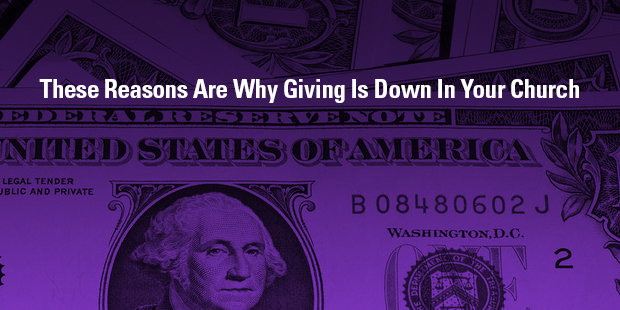
These Reasons Are Why Giving is Down in Your Church
You are trying to comprehend why the giving levels in your church are down. You may know several possibilities, but you aren’t certain. As I have worked with several congregations, we have isolated the issue to one or a few causes. See if any of these causative factors may be at work in your church.
- Lower attendance. Okay, I may be stating the obvious here, but it is worth noting. I spoke with a pastor whose church’s giving is down 15 percent from a year ago, and the attendance is down 12 percent. There is a high correlation between attendance and giving, even if you have a strong online giving component. It is also worth noting that attendance frequency is down in many churches, if not most churches, as well. The family who attends three times a month is more likely to give more than the same family attending two times a month.
- Generational shifts. Builders, those born before 1946, are more likely to give to the church out of institutional loyalty. Boomers and Gen X have the highest family incomes, but their giving is not as consistent. Millennials thus far are not strong givers in our churches. In many churches, the Builders are being replaced with Millennials. In other words, more generous givers are being replaced with less generous givers.
- Giving to purposes rather than organizations. From the Builders to the Millennials, there has been a dramatic shift in the motivations for giving. The Builders, as noted above, are more likely to give out of institutional loyalty. Thus, church leaders could exhort this generation to “give to the church,” and they would respond positively. The Millennials, however, give to purposes rather than organizations. Church leaders must demonstrate with specificity how the funds in the church are being used for a greater purpose. And that greater purpose must be real, personal, and compelling.
- Little teaching on giving. The pendulum has swung too far. In an overreaction to the constant pleas for money twenty years ago, more church leaders are hesitant to even mention the spiritual discipline of giving. Frankly, many of our church members do not comprehend that giving is both a mandate and a blessing, because they have not been taught about it in their churches.
- Not as much discretionary income among churchgoers. Before you object to this point, I know fully our discretionary income should not be the basis for our giving. God should get the first fruits, and not the leftovers. But the stark reality is that many people who do give to churches only give their leftovers, or their discretionary income. Though the economy has improved over the past few years, most of the growth in discretionary income has been in the top 20 percent of household incomes. Yet those who attend our churches are more likely to be a part of the other 80 percent. Simply stated, most of our church members have not seen increases of any size in discretionary income.
There are obvious actions we can take toward this challenge. We can teach and preach unapologetically on biblical stewardship. We can be clearer on the purpose or the “why” behind the giving. And we can offer different mechanisms for giving to make it more like a spiritual habit rather than a negligent afterthought. My church, with under 200 in attendance, offers traditional giving, online giving, and text giving. Many churches still do quite well with envelope giving.
Giving is just one part of a culture of Generosity. Learn more by connecting with an Auxano Navigator.

Tags: Giving decline, Thom Rainer, church giving decrease, cultivating generosity, giving decrease












